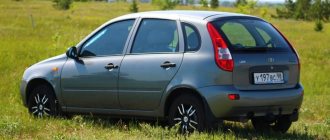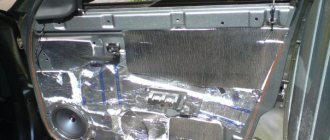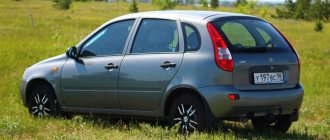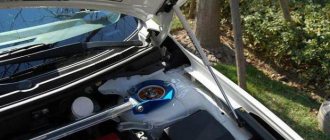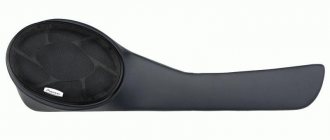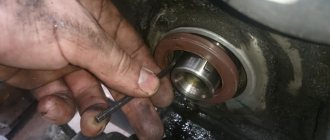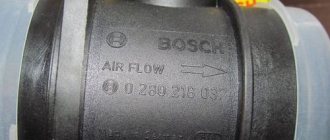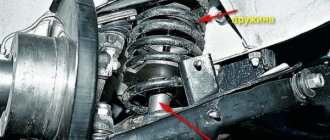As an additional equipment, LADA vehicles can be equipped with a towing device (trailer hitch or towbar). The towing device is designed for articulated coupling of a vehicle with a towed trailer. The design of LADA vehicles provides for the possibility of installing a trailer hitch without additional mechanical influences (drilling holes, welding) on the vehicle body. The following are instructions for installing and connecting a standard towbar on cars of the Lada Priora family.
For each LADA car model, several trailer hitch options are offered for installation, differing in design, but identical in the method of attachment to the car body.
The trailer hitch, regardless of the model and design of the device itself, is attached to the rear power elements (side members) of the car body.
Tightening torques for threaded connections
:
- M6 – 9.8 Nm (0.98 kgf/m);
- M8 – 24.0 Nm (2.4 kgf/m);
- M10 – 47.0 Nm (4.7 kgf/m);
- M12 – 81.0 Nm (8.1 kgf/m).
A Question of Choice
Today, the problem when choosing a towbar for a Priora, as well as for other cars, is not a shortage of auto parts, but an excess of them. For Lada, which is the hero of discussion today, experienced motorists distinguish three brands. This:
- AutoS. A Russian company that has earned a calling not only at home, but also abroad, for the quality of its products. Offers a clutch for Lada Priora at a low price, but meets the standards and does not cause problems during installation.
- Leader Plus. Also a Russian manufacturer, producing copies for domestic cars and not only. Drivers highlight only the advantages, because the towbar costs little, but it has no problems with installation on the car.
- Trailer. The quality of this Russian company is also maintained at a high level, as is the opposite price level for Russian cars. The towbar on the Priora from the Trailer fully justifies the stated parameters.
And although there are other manufacturers of couplings, it is not known whether they offer models adapted for Priora. This can only be found out by contacting the company, the official website, or when searching for a car accessory in a store. As for foreign products, these are not worth taking for Russian cars. It's expensive and unjustified. Find out which companies produce the best towbars from this article.
Towbar on Priora station wagon
Special attention should be paid to the type of ball design, because there are three options:
- Quick release tow bar.
- Conditionally removable.
- Welded.
What is a sedan, hatchback, station wagon, crossover
Many people who deal with cars wonder what the differences are between cars with different body types, such as an SUV and a crossover, a sedan or a hatchback.
For example, if you look at a BMW 6 Series Gran Coupe and try to determine what body type it belongs to, you can easily make a mistake. The difficulty is that this model looks like a typical sedan, but for some reason it belongs to the coupe class
Despite this, due to the wide variety in the modern automotive market, mistakes can occur even for people who are well versed in the world of cars.
What are the differences between different categories of cars?
Vehicles for off-road driving. To be able to easily distinguish SUVs from crossovers, you should clarify on what platform a specific car model is created.
Much attention should also be paid to the dimensions that each type of car has. The thing is that full-fledged SUVs have quite impressive dimensions
According to the information contained in the international classification of SUVs, they are based on a frame platform, where the body is secured to a strong frame. Immediately after their appearance, all representatives of this class were made on a frame type chassis with a high level of ground clearance. After some time, thanks to the high popularity of this class of cars, cars were created in which the body was the load-bearing part and there was no frame. They are called crossovers.
Almost immediately after its creation, most cars of this class were equipped with an all-wheel drive system. Over time, in order to save money, all-wheel drive began to be connected using the AWD system, that is, with reduced interaction with the road surface.
Hatchbacks and station wagons. Both cars belong to the universal category of automobile transport when compared with sedans or coupes. In fact, their technical characteristics are closer to the previous pair of cars.
The main difference between this class of cars and all others is the larger luggage compartment volume, which is achieved due to the ability to fold the rear seats. The second positive point is easier access to the luggage compartment than in sedans and coupes. Externally, these cars can be distinguished by the body kit on the rear side of the car, which is significantly different. Unlike hatchbacks, the station wagon body is slightly longer. Most often, the roof of a station wagon is as long as its rear edge. The rear overhang is designed to create more cargo storage space. In hatchbacks, it does not reach the rear edge of the car.
Sedans and coupes. Previously, it was not particularly difficult to distinguish between sedan and coupe cars. A car with four doors was considered a sedan, and a car with two was considered a coupe. But, with the development of the car market, this principle ceased to apply, thanks to the advent of four-door coupes and two-door sedans.
To determine whether it is a coupe or a sedan, just look at the car's pillars from the side. Cars with a sedan body type have three support pillars, of which the middle one serves to support the doors. It is not available in coupe-type vehicles. Another difference from sedans is the closer location of the front seats to the rear of such a car.
There are also a small number of machines that do not fit into any of the above categories. These include, for example, a Nissan Murano.
Prodigy. Test drive Genesis G70
See all photo news >>
Installation diagram
If the towbar on the Priora is chosen correctly, then there will be no problems with installation. And the standard installation sequence includes the following steps:
- Dismantling of some auto parts.
- Installation of the metal structure of the coupling device.
- Installation of electrical wiring.
- Reassemble the car in reverse order.
- Carrying out a road test in conjunction with a trailer. Including testing of lighting equipment.
Due to the importance of the installation stage of metal structures and electrical equipment, we will analyze these stages in more detail.
Preparing for towbar installation
Basic faults
Exceeding the permissible load can affect the condition of the trailer hitch. Because of this, it becomes deformed, but may even break off on its own. If it has a removable ball, it may come off. The question is when the malfunction will appear - while the car is standing or while it is driving.
The second problem is the lights going out due to insufficiently strong wire connections. In order to avoid getting into an unpleasant situation, pay attention to the fastening of the bolts, the connection of wires, and their insulation. The main thing is not to exceed the maximum permissible load of the device, even if the trailer is capable of carrying more weight.
Installation work
More often, the towbar is equipped at the factory with a pad for the platform, stiffening plates and rubber shock-absorbing inserts. Although professionals advise installation at service stations, more often drivers are interested in how to install a tow bar on a car with their own hands. In answering this question, we will list the necessary equipment and tools. It will include:
- Drill with drills.
- Multi-grade sandpapers.
- Water with a cloth to remove dirt.
- Degreaser.
- Rags.
- Anti-corrosion composition.
- Jack or inspection hole.
- High quality lighting.
Video about installing a tow bar
The mechanical installation sequence is simple. To begin with, the driver drills holes in the appropriate places, but not in contact with the electrical wiring. We clean them with sandpaper and treat them against corrosion. Afterwards it is necessary to apply a sealant for waterproofing.
Toyota Crown 1G-GZE gold › Logbook › Sedan, hatchback, coupe and others...Learning materiel
Sedan, hatchback, coupe and others... We learn materiel
The body is a kind of metal glazed shell that houses the three main components of a passenger car: the power unit (engine), passengers and luggage. They can be arranged in different ways, and the shapes of the bodies differ from each other.
The most common are: sedan, station wagon, hatchback, coupe and, increasingly popular in Russia, minivan. Perhaps everyone knows what a limousine and a convertible, a van and a pickup truck look like. But only the most ardent car enthusiasts can imagine what a landau, brogue, roadster or fastback is.
A three-volume body with two or three rows of seats, two or four doors and a trunk structurally separated from the passenger compartment. This body model is typical for most passenger cars. The volume of the trunk and interior differs. Convenient for transporting passengers, but practically not intended for transporting cargo.
The rear window on a sedan is always rigidly fixed in the frame and does not rise, although the back of the rear seat can either be equipped with a hatch or recline to transport long items. In North America, this body style is often called a notchback. A sedan without B-pillars, and sometimes with door glass without outer frames, is called a hardtop sedan. A sedan with two doors is called a Tudor. This body type is the most common among passenger car bodies.
A two-volume body with three or five doors with one or two rows of seats, having a permanent cargo space not separated from the passenger compartment by a stationary partition (the rear row of seats is folding). Passengers in the third row of seats can also sit either with their backs to the direction of travel, or in separate seats along the sides of the body.
A two-volume cargo-passenger body with two or four side doors and one cargo door in the rear of the body (the total number of doors is three or five). Two rows of seats. The second row and the shelf behind it can be folded or removed altogether, dramatically increasing the useful volume of the cargo space. The trunk is typically smaller than sedans, but folding rear seats and a roof-to-bumper tailgate allow the hatchback to load and carry fairly bulky items. The roof slopes smoothly back, and there is a large luggage hatch in the rear wall. It differs from a station wagon in its smaller trunk volume, and from a minivan in its lower height.
A closed three-volume or two-volume passenger body with two or (less often) three doors (the third is located at the rear and combined with the trunk) and two rows of seats. The second row of seats may have limited seating dimensions. Despite the fact that initially a “coupe” is a body type designed for two passengers, there are often cars with a 2+2 seating arrangement (in this case, the rear seats are intended exclusively for children) and even full-fledged four-seater designs. Such body models are often used in sports cars. They are distinguished by high comfort for the driver and front passenger. However, having only two entry doors makes getting into the back seat difficult, if there is one at all. The trunk of these models, as a rule, is slightly larger compared to a sedan, but not significantly.
Sometimes this body type is divided into subtypes:
• Sports coupe • Executive coupe
Minivan or UPV (high-capacity station wagons) minivan
A kind of cross between a bus and a station wagon. Single-volume cargo-passenger body with two, three or four side doors, two or three rows of seats. The rear part of the cabin, as a rule, is similar to a station wagon body, but has a greater number of transformations of seats and equipment. The minivan evolved from a van converted to carry passengers. The minivan's capacity is up to 7 people, which does not require an additional D class driver's license. The luggage compartment is small but roomy.
Electrical wiring installation
It is better to entrust the connection to professionals to prevent electrical wiring damage. When installing electrics yourself, the steps are as follows:
- Emptying the luggage compartment, including carpets.
- Opening access to the electrical wiring harnesses of the vehicle's rear optics.
- Turn on the dimensions to search for the corresponding wire on the left lamp using a tester.
- Fasten and mark a 0.6 meter piece of wire in this place.
- Turning off the side lights.
- And turning on the right turn signal for subsequent similar markings.
- Further, the rear lights with brake lights are also determined.
- And then the electrical wiring is connected into one bundle, which is removed through the technological hole.
- Pulling wires to the towbar socket. For information on how to connect a towbar socket, read this article.
- Connecting the marked wires with the coupling electrics according to the diagram.
- Connecting the trailer plug.
- Functionality check.
At the stage of connecting the electrics, it is important to pay special attention to the insulation of the wiring, because if the standards of this stage are not followed, there is a possibility of a car fire.
Thus, choosing a towbar for a Priora is similar to the process for other cars. However, it is worth being familiar with the classification of towing devices, having information about manufacturers that produce devices specifically for this car, and also knowing how to install a towbar on a passenger car with your own hands.
Towbar (trailer hitch, towing device) – article number and price
AvtoVAZ has regulated which towbars can be connected to the VAZ-2170, 2171, 2172. These include the following models, which can be found in auto parts stores:
- Manufacturer: Leader-Plus for Lada Priora, T-VAZ-05A, 2097 rubles, Vaz 05FC, price – 2010 rubles. For them, the maximum load will be 900/75 kg;
- Avtos VAZ-10, 2500 rubles, load up to 800 kg, VAZ-40 - 2580 rubles, load up to 750 kg, VAZ-60 - 3000 rubles, load up to 800 kg. Please note that the manufacturer produces products of the specified articles with or without electrics, so check whether wiring is included in the kit before purchasing, if it is needed;
- Bosal Russia 1226-H – 3160 rubles, up to 800 kg, 1226-A – 3250 rubles, up to 800 kg;
- Trailer 2170, price – 3450 rubles, up to 800 kg;
- Sheriff SF.2871.12, price – 3450 rubles, up to 800 kg.
